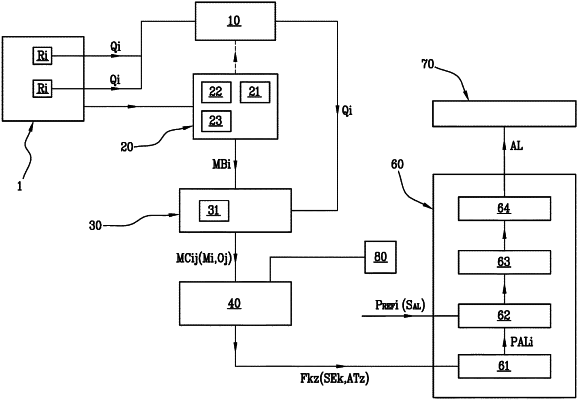| CPC G16H 50/50 (2018.01) [A61B 5/1114 (2013.01); A61B 5/45 (2013.01); G16Z 99/00 (2019.02)] | 14 Claims |

|
1. A method for identifying at least one alteration in a musculoskeletal system of a subject, the method comprising:
associating, with said subject, detecting means comprising sensors for electrical activity detection configured to detect physical quantities representative of a state of said subject, wherein said associating comprises positioning said detecting means on said subject;
detecting, in real time, said physical quantities through said detecting means, aligning said physical quantities in time, and sending said physical quantities to an identifying unit, wherein said identifying unit controls a step-by-step user instruction procedure that guides a user by means of a graphic interface provided with buttons and controls, the guiding of the user by means of the graphic interface comprising showing the user how to position said detecting means on the subject and how to activate the detecting means;
generating a biomechanical model for said subject by said identifying unit, wherein the generating generates the biomechanical model as a function of execution of said step-by-step user instruction procedure, which provides an optimized multi-segment and multi joint analysis on the subject;
providing, by the identifying unit, a feedback to the user confirming successful conclusion of the generating of the biomechanical model for said subject;
determining combined movements of muscles and bones as a function of said physical quantities and said biomechanical model, and displaying the muscles and the combined movements of muscles and bones on a display, the muscles being represented by textures with colors of the textures being dynamically controlled to modulate the colors based upon values of signals received from the detecting means and a set of threshold values;
converting said combined movements of muscles and bones into a plurality of movement steps of human body segments of the subject and human body joints of the subject, wherein said movement steps are computed as a function of:
first joint parameters (Pz) of a first joint (Atz) and at least one second joint parameter (Pz+1) computed as a function of second joints (Az+1) affected by the movement of the first joint (Atz);
identifying the at least one alteration based on a failed matching between parameters (PALi), determined based on the plurality of movement steps, and predefined reference values representative of alteration thresholds in the musculoskeletal system, wherein the identifying is carried out by an identification module of said processing unit; and
determining a belonging of said at least one alteration to one or more groups of musculoskeletal pathologies, wherein the determining is carried out by a classification module of said processing unit.
|